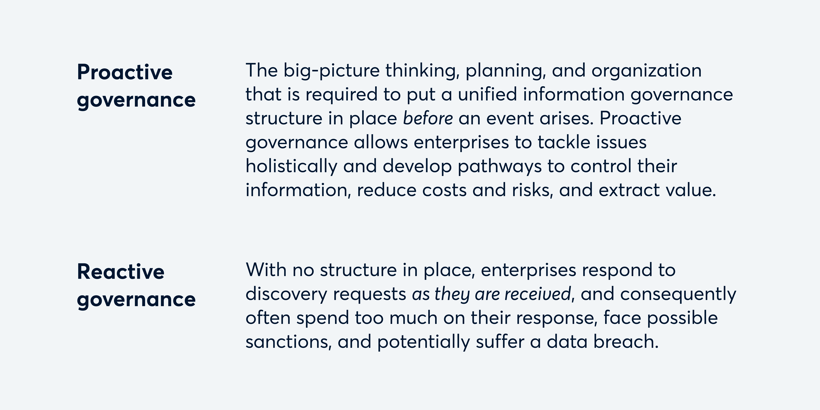How to leverage the IGRM to save on eDiscovery

Discovery is hugely expensive, mainly because many organizations collect whatever data is available rather than only the information that matters. Governing and retaining your data will decrease eDiscovery costs by culling down the data and providing you with access to your dispersed data sources. However, it’s a team effort, and you cannot have unified information governance within a siloed company.
This blog is based on one of our popular webinars, hosted by EDRM. Click here to watch the video and download the slides.
The enterprise data landscape
The massive adoption of best-of-breed applications during the pandemic and the move to a hybrid work environment have dramatically driven data growth and complexity within enterprises. As a result, it has become more challenging to govern the sheer magnitude of data to meet legal and compliance obligations.
According to a recent study by the global market intelligence firm IDC, the Global DataSphere – how much new data is created, captured, replicated, and consumed each year – is projected to more than double between 2022 and 2026. In addition, the Enterprise DataSphere is expected to grow over twice as fast as the Consumer DataSphere during the same period, putting increasing pressure on enterprise organizations to manage and protect this data while creating ways to activate data for business efforts.
What does this all mean? Every two to three years, enterprises double the amount of data in their organization. In addition, the types of data retrieved for litigation, forensics, and the investigation process are becoming much more complex. There is also a large amount of unstructured data – user-generated data delivered as part of day-to-day enterprise interaction on systems like Slack, Gmail, and Outlook.
By some estimates, 20 percent of all available unstructured data is not controlled or managed properly. The obligations to retrieve this data are also multiplying exponentially – where we used to have a needle in a haystack in one system, we now have a hundred or more to handle. All this data is impacting the way we handle investigations, the way we interact with stakeholders, and the way we must manage eDiscovery.
Current trends affecting eDiscovery
As we head into 2023, the eDiscovey landscape is at a crossroads. Data volumes continue to explode, at least in part due to new data types and technology platforms. In the coming year, eDiscovery will likely be impacted by several key trends, including:
- Software-as-a-service (SaaS). Cloud-based solutions are growing at warp speed and are likely to overtake traditional IT approaches within the next several years. According to Gartner, enterprise IT spending on public cloud computing will exceed investment in traditional IT by 2025. Cloud offerings are expected to rise to $655 billion in revenue by 2023, an increase of $111 billion over 2022.
- Structured data. Most data – Word documents, digital photographs, emails, text messages, Zoom meetings, and more – is unstructured, meaning it lacks an identifiable structure or predefined model, making it challenging for technology to manage and store. However, a widespread increase in structured data – discoverable information stored in complex applications and databases – has been observed.
- Automation. Investment in legal technology will continue to surge. Gartner research has found that mounting pressure on legal departments to increase responsiveness and efficiency will lead to greater adoption of automation, artificial intelligence (AI), and machine learning. Approximately 40 percent of all in-house legal departments plan to increase spending on legal technology by a minimum of 10 percent by 2023.
- Work models. The pandemic forced the legal industry to shift to a remote work model nearly overnight, and over two years later, remote and hybrid work models persist. This change affected where and how eDiscovery professionals do their jobs and expanded the amount and kinds of data created by this remote workforce. However, since cloud-based eDiscovery solutions are scalable, they can more easily accommodate growth.
- Data experts. More than 2.5 quintillion bytes of data were created daily in 2021, yet the legal industry has been hesitant to integrate data management into the practice of law. However, some law firms and legal departments see the value of incorporating data into their day-to-day workflows and include data experts on their staff. This trend is expected to continue in 2023.
- Information governance (IG). Information governance provides a framework for how an organization comprehends and controls its information, and the IGRM (Information Governance Reference Model) defines a unified governance approach to information. In addition, legal technology will increasingly offer organizations a consistent and systematic approach to optimizing information management, resulting in more efficient and effective eDiscovery processes.
From an eDiscovery perspective, everything is a document. The detailed insight that IG, technology, and automation provide will help legal teams drill down to the truth of matters quickly and efficiently to jumpstart eDiscovery while maintaining compliance.
How proactive governance can help streamline eDiscovery
Enterprises need to lower the costs and risks associated with managing data, yet still be able to extract value from the information they possess. Companies typically approach this in one of two ways:

In eDiscovery, external events often trigger a shift into a proactive mode when being reactive to a given situation is not producing the desired results – manageable costs, less risk, and defensibility.
Leveraging the IGRM to enhance discovery
The Information Governance Reference Model (IGRM) is an extension of the E-Discovery Reference Model (EDRM) that is intended as a road map to guide corporations regarding how to manage their organization’s information. The IGRM is not driven by an end or beginning of a trigger event for discovery (such as filing a case or launching an internal investigation). Instead, it provides common language and discussion points to support legal stakeholders in their balancing act between privacy, information governance, discovery, and litigation. Ediscovery technology, machine learning, natural language processing (NLP), and other artificial intelligence (AI) technologies can support the analysis, organization, management, and identification of information to achieve balance.
However, technology is ineffective without the expertise to leverage and expand its capabilities fully. Unfortunately, there is no “easy” button to implement the complicated business workflows required to support an organization’s privacy, information governance, discovery, and litigation use cases. These workflows continually evolve and can vary widely across use cases and even within them, depending on the parameters. But with guidance from the best practices outlined in the IGRM, knowledgeable eDiscovery professionals can leverage technology to support the ever-changing workflows that organizations face.
Best practices for implementing a modern information governance strategy
Simply put, information governance (IG) is managing an organization’s information, including employee files, financial records, thought leadership pieces, website data, confidential client information, emails, social media posts, and much more. In addition, IG encompasses the numerous policies, procedures, structures, and processes that organizations must comply with when generating, managing, and sharing information.
With an estimated 2.5 quintillion bytes of data created daily, data breaches are no longer a possibility but rather a probability. To protect company information, enterprises should apply some best practices to protect data and support compliance, including:
- Discourage company silos. You cannot have unified governance in a siloed company. Information straddles the enterprise, so information governance must follow suit. When data is thought of as solely mine or theirs, unified governance cannot exist.
- Manage change. Information governance should be treated as a journey, and any IG strategy must effectively manage and enable change. Compliance is imperative and should be encouraged at the senior management level.
- Create training programs. Training programs with any new IG initiative will be critical and should be mandatory for everyone within the organization. Training programs should be crafted according to the business’s specific needs and focus on the users’ work environments.
- Implement an e2e eDiscovery approach. An e2e (end-to-end) discovery approach provides bundled solutions to support a project from beginning to end to help cut costs, provide a unified system, and ensure continuity throughout the entire process.
- Hold regular meetings. A cross-functional team should meet regularly (quarterly if possible) to assess performance reports, new technology, conflicts, budget concerns, and management changes. Strategies should be modified based on the information gathered at these meetings.
Whether an enterprise is just beginning to develop an IG policy or is reevaluating current procedures, these best practices will help achieve the organization’s objectives and protect critical business information.
Let Onna give your enterprise a heads-up on information governance
The Onna Platform provides the tools enterprises need to get ahead of the information governance curve. To find out more, download our eBook, “Rethinking information governance in the age of unstructured enterprise data,” today.

 eDiscovery
eDiscovery Collections
Collections Processing
Processing Early Case Assessment
Early Case Assessment Information Governance
Information Governance Data Migration
Data Migration Data Archiving
Data Archiving Platform Services
Platform Services Connectors
Connectors Platform API
Platform API Pricing Plans
Pricing Plans Professional Services
Professional Services Technical Support
Technical Support Partnerships
Partnerships About us
About us Careers
Careers Newsroom
Newsroom Reveal
Reveal Logikcull by Reveal
Logikcull by Reveal Events
Events Webinars
Webinars OnnAcademy
OnnAcademy Blog
Blog Content Library
Content Library Trust Center
Trust Center Developer Hub
Developer Hub